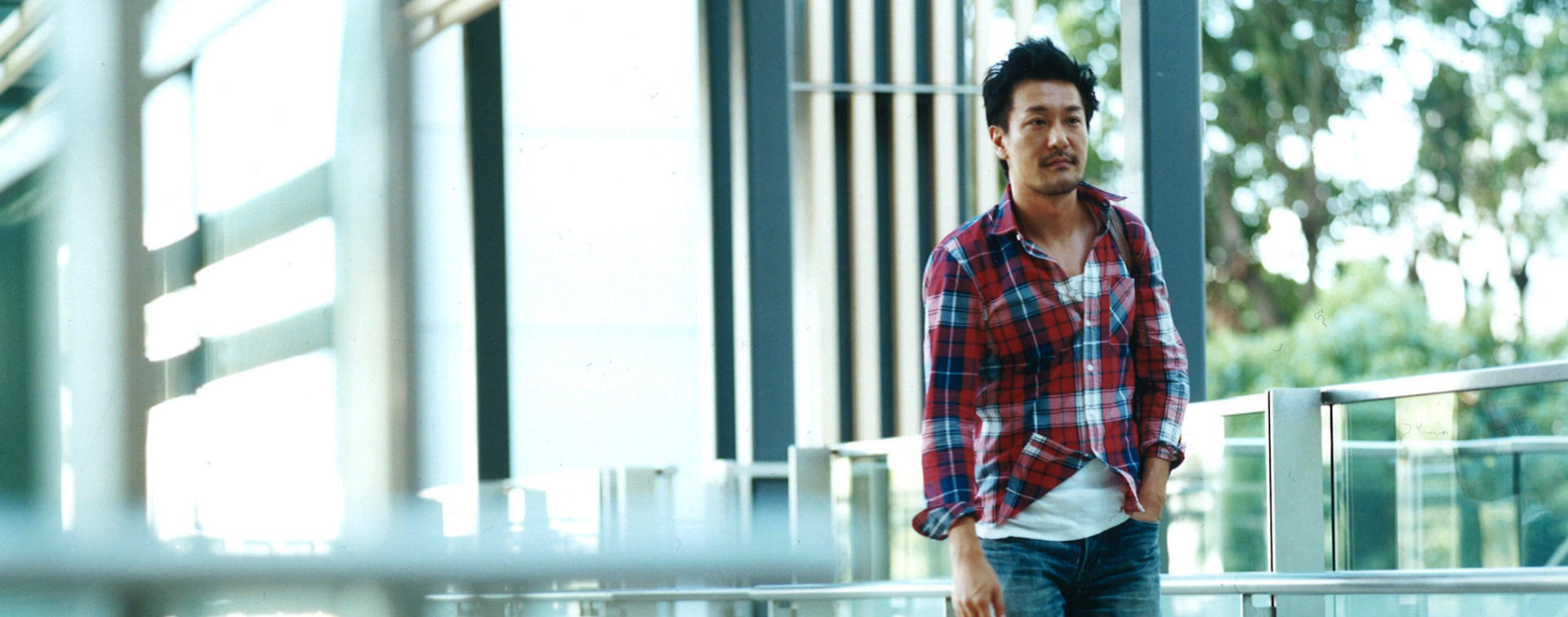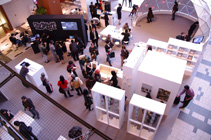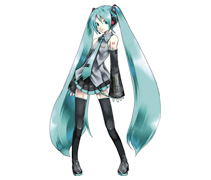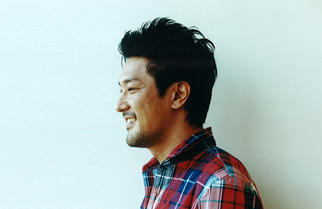


How would you turn Roppongi into an area of Design & Art?
Become a place for creations which have not even been specified by genre and whose values are yet uncertain
- JP / EN
Toshiyuki Inoko did not show up at the appointed time on the day of the interview. We asked him what had happened when he finally arrived, and he told us he had been looking everywhere for the interview room. He added that he always gets lost in Roppongi buildings. Inoko is the standard-bearer of next generation digital art. In 2001, while a student at the University of Tokyo, Inoko set up teamLab Inc., a group of ultra-technologists, with the aim to rejuvenate Japan. He is continuing to take up the challenge of creating new expressions in the digital domain. Inoko is constantly giving thought to the values of Japanese culture and the things that have impact on the post-Internet society. We asked him his views on the future of Roppongi.
Roppongi seen from Japan or seen from the world?
When you say "an area of design and art", you have to consider whether you want Japan to look at Roppongi as such an area, or whether you want to have the whole world look at Roppongi that way. There's a huge difference between the two. If you are aiming to have Roppongi become an area of design and art within Japan, I think that's already been achieved to a certain extent, and the recognition will become even stronger if you go on with what you are doing now. If, on the other hand, you are aiming for worldwide recognition, then I don't think that the rest of the world will ever think of Roppongi as an area of design and art. To be more specific, Roppongi will never get that kind of recognition if things continue as they are.
I assume that you are saying "design and art" in Roppongi in the same context as design and art in New York. Well, if you mean the same kind design and art as in New York, you can't win. New York has been a city of design and art for ages. The representative artworks in Roppongi are also works that would also be highly appreciated in New York. They are completed pieces that are appreciated under a set of values established in the 20th century, and it is such works that are being chosen and collected in Roppongi. But if you keep doing that, I feel that the world will never look at Roppongi as an area of design and art.
Becoming a place to show new culture
If the aim is to have Roppongi become known in the world for design and art, you should think of becoming a place that accepts new culture - new culture whose values have not yet been determined, but which undoubtedly will have value in the future. Its genre may be uncertain and it may not yet have a proper place to be shown.
For example, a lot of people are looking at things on the Internet and getting excited about them, but sometimes there are things which people cannot quite explain. Such things will probably never be exhibited at the Biennale di Venezia (international contemporary art exhibition) or at the Milano Salone (international furniture fair and the world's largest design event). But in reality, many people are interested in the fuzzy things that can't be specifically named yet, and I feel that these are the creations of the future. If Roppongi becomes a place to show such works, I think that in 10 or 20 years, it will be able to become a symbolic "creative city."
Venice, Milan, Linz
Biennale di Venezia has been showing contemporary art for more than 100 years, and Milano Salone has been showing product designs for more than 50 years. Even the media event Ars Electronica held in Linz, Austria has a 30-year history.
When Ars Electronica started in 1979, it must have been a niche genre. I wonder if the term "media art" existed then. In those times, the desktop calculator was about the only computer you would commonly see. Incorporating technology in art was not the mainstream, and yet it proved to be the future. That's why Ars Electronica became a symbolic event for this genre, and the town also became a symbolic town. There's even talk of having cities like Yokohama and Osaka become "creative cities" by hosting Ars Electronica. But we won't be able to win by hosting that event today. Well, that goes without saying.

Ars Electronica
The world's largest media art festival held in Linz, Austria. A wide range of art works and works using the latest technology from around the world are shown here every year. Many Japanese have won awards at this event. Tokyo Midtown held an exhibition in collaboration with Ars Electronica in 2010.
http://www.tokyo-midtown.com/jp/designtouch/2010/index.html

Expressions made possible by digital technology
I think there are many things which cannot be identified yet, but which have the potential of becoming new forms of culture. I happen to be interested in the post-Internet society, and I think that not only the digital aspects of design and art but other things belonging to the digital domain will become the new pillars for society's values. So I see potential in media expressions that are made possible by the Internet and the digital domain.
I'm not necessarily recommending this for Roppongi, but Hatsune Miku is a product that typifies what can be made by using the Internet and digital expression. It's something that comes from our cultural background. People are really fond of Hatsune Miku and it seems to belong to a new creative genre. Yet we are not sure what it exactly is. We don't know whether it belongs to the genre of music or whether it is art, and it seems almost unnecessary to write a rigid description of it in the context of art.

Hatsune Miku
Computer music software that incorporates singing synthesizer system. Put on the market in 2007 by Crypton Future Media, Inc. Many internet users have been captivated by the cute female character and her pretty voice. Many videos using this software have been posted on video-sharing sites like "Nico Nico Doga".
Illustration by KEI (c)Crypton Future Media, Inc. www.crypton.netConcepts can be unexpectedly weak
The interesting things are those that are difficult to be defined as either design or art.
Concepts can be unexpectedly weak, you know. There are things on the Internet which people are talking about which perhaps can be called entertainment or design or art, but which cannot be defined in a proper context. They are nonetheless forms of expression which people feel are new and inspiring, and in about two years from now, they will become common. Things are changing so fast in a powerful way.
Roppongi needs to have a strong will to become a place for new culture and creations. A strong will for the future is needed because you have to set your mind to becoming such a place while thinking about 10 years or 20 years on from now. You have to have the will, and you might even call it courage. Courage is not needed to pick up works that have already gained global recognition; you could make a collection of such works if you have the money. But it's quite difficult to choose works whose values people are not sure of. You also need a strong strategy - a strategy to win in the world. I mean, there's no point in Roppongi becoming a second-rate version of New York.
Akihabara - seen by the world as a creative city
In Japan now, Akihabara surpasses all others in being the place for the newest culture. Akihabara has pure tolerance and freedom. It's relatively cheap to get there, and it keeps changing at a tremendous pace. All the transformations that have occurred in the past have led to what Akihabara is today.
After World War II, there was the black market and then came the age where the radio was the new media and everyone could possess their own communication tools. With places like the Radio Kaikan which sold radio parts, Akihabara became one of the world's most important towns for wireless goods. Later it became a town for electronic goods including household appliances. Then it became a town for personal computers, and then a town for digital content - so-called two-dimensional content. But that faded fast, and then it became a town for maids in a rather two-and-half dimensional way. Now it's a town for idols. Yet despite all these transformations, the Radio Kaikan still stands and is beloved by the people of the town. Akihabara has this tolerance and positivity toward all kinds of change.
In Akihabara, transformation is accepted and integrated, and freedom and tolerance are guaranteed. That's why new forms of culture are born there with such strong momentum. Akihabara is the most famous Japanese city in the world, and the world sees it as a creative town. People in the world are far more interested in knowing what is popular in Akihabara than what is popular in Roppongi. That's a fact, you know.

Tolerance and freedom are the common traits of my favorite places
I live in Akihabara, so of course it's one of my favorite towns, but I also like Bangkok. I think that anyone who goes to Bangkok will fall in love with it. It's similar to the way I described Akihabara; it's extremely tolerant - tolerant and free. And there's a rich culture. You go into an ordinary, nondescript shop and you find that the graphics are of a high standard, and there is stylishness.
Japan and Thailand are the only Asian countries that were not colonized by the West. Japan lost the war, but Thailand did not even go through that experience. Because of that, Thailand might be the country least influenced by Western thinking and values. Having evolved with values that are different from the West, Thailand seems to have retained all the good aspects of an Asian country in the best possible way. When I'm in Bangkok, I realize how wonderful the whole of Asia really is.
The people of the Land of Smiles are rational?
Since the Meiji Restoration, Western values have tended to influence the way Japanese people appreciate things. On the other hand, there has always been the flow of mass culture, as typified in the popularity of products like Hatsune Miku. Seen from the perspective of mass culture, Thailand has an exceptionally high level of originality and creativity. For example, there's the manga artist Wisut Ponnimit. You may not have heard of him, but you have probably seen his works.

Wisut Ponnimit
Thai manga artist. Known affectionately as "Tam-kun", Wisut Ponnimit has many fans in Japan. In 2009, he won the Encouragement Prize in the Manga Division of the Japan Media Arts Festival held by Japan's Agency for Cultural Affairs. Among his works is "Blanco" published by IKKI Comics.
c『Blanco』wisut ponnimit/Shogakukan IKKIAnother interesting fact about Thailand is that people are embarrassed about getting angry. They think getting angry is a foolish thing to do- utterly foolish. I personally think that anger is sometimes necessary in communication, but I find that the people of Thailand simply don't show anger. Instead, they suddenly disappear from view.
I think the Thai people have a point because if you really get angry, your relationships with people will break down. You can be angry for an hour, but if your relationship with someone is going to end anyway, that hour would have been a waste of time. It's a really rational way of thinking. Thailand is said to be the land of smiles, and the reason is that people just go away before they get angry, and a result, it looks as if people are always smiling. (laughs)
Why do they tell us not to dance?
Oh yes, there's something I'm hoping that Roppongi will work on. I want Roppongi to fight the Entertainment Businesses Law. When you go to clubs now, there's a sign in the toilet that says, "This establishment absolutely prohibits dancing." It's just weird. Apparently the Entertainment Businesses Law that was made long ago includes regulations against people dancing and eating and drinking in establishments. They still implement that law today and tell us not to dance. Why are they motivated to arrest someone who raises his leg? To tell someone not to dance is so strange.
Before things like design and art came on the scene, the culture of Roppongi was shaped by the clubs and live houses. It cannot be right to say "no" to that. So why do they do it? I would very much like to know why.
Editor's thoughts
Inoko-san came to the interview laughing loudly. And it was with a roaring laugher that he left when the photo shoot was over. Yet when we talked, there was a long silence that lasted for about five minutes, and it was the most thrilling interview I have experienced. From Inoko-san's comments it was clear how strong his feelings are for Akihabara. (edit_rhino)



















